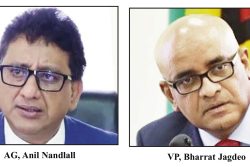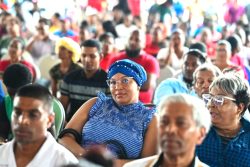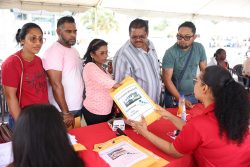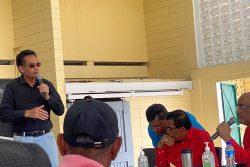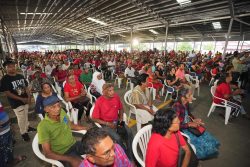Since I first saw Mashramani in 1968, the festival has had an uneven history. I remember some years when it was clearly struggling to find its feet – frail is the adjective that comes to mind – but within the past couple of years, driven by a concentrated effort from the Ministry of Culture, Mashramani appears to have caught a second wind. This year, there was a renewed vigour and excitement both among the revellers on Irving Street, and in the huge turnout of the public even though rain had been forecast. Thousands were there from early in the day, and most encouraging was the mixture that came to the party. All stripes, however you choose to interpret that, were there – all colours, all ages – and there was a striking combination of performer excitement and spectator satisfaction. From a distance, or up close, this year, for the first time in a while, there was a widespread happy embrace for Mash in Guyana, including even some sponsorship interest from local businesses.
 I have spoken before of Guyana’s need for a powerful cultural engine, to propel our entertainment industry as well as tourism, but more so for the invigoration such things provide for a developing nation such as ours. The experience in 2011 shows that Mashramani has the potential to be expanded into such an engine, but to achieve that our government must commit to a greater financial contribution to the festival’s operation. As is the case with so many of our festival neighbours in the Caribbean, cultural engines such as Trinidad Carnival, Barbados Cropover, Cayman Pirates Week, and St Lucia Jazz have to be propelled (notice the increased government contribution in Trinidad’s carnival this year), and while the private sector has a critical role to play, a substantial investment by government is the sine qua non in their success. For those who may have had doubts before, Mashramani’s impressive impact this year signals that even greater returns await a greater push. In the long term, this increased investment will benefit both Guyana’s economy as well as the face we present to the world, but the push must start now.
I have spoken before of Guyana’s need for a powerful cultural engine, to propel our entertainment industry as well as tourism, but more so for the invigoration such things provide for a developing nation such as ours. The experience in 2011 shows that Mashramani has the potential to be expanded into such an engine, but to achieve that our government must commit to a greater financial contribution to the festival’s operation. As is the case with so many of our festival neighbours in the Caribbean, cultural engines such as Trinidad Carnival, Barbados Cropover, Cayman Pirates Week, and St Lucia Jazz have to be propelled (notice the increased government contribution in Trinidad’s carnival this year), and while the private sector has a critical role to play, a substantial investment by government is the sine qua non in their success. For those who may have had doubts before, Mashramani’s impressive impact this year signals that even greater returns await a greater push. In the long term, this increased investment will benefit both Guyana’s economy as well as the face we present to the world, but the push must start now.
To begin with, the Mash Secretariat needs to be in operation year-round, planning the event far in advance, promoting it abroad, and working at home to increase the private sector involvement that is critical to its success. Selling the idea of the festival as a development vehicle for businesses is a long-term combination of data collection and analysis, phone calls and letters, individual presentations, and call-back efforts; it cannot be achieved in a few months. In my experience in a festival abroad, the securing of substantial private sector involvement can sometimes take two years to materialize, and I’m sure the experience here will be similar. Businesses make their financial decisions far in advance; approaches for sponsorship must be on the same schedule.
The interesting widening of the festival content, which was another part of the ministry’s work this year, should be sustained. My experience in the Cayman festival was that a variety of activities was important. Some people have no interest in the costume bacchanal part of a festival such as Mash (many Trinidadians actually leave the island during carnival) but would be drawn to other cultural or artistic events. Sports events on the Mash calendar would widen its pulling power. In Cayman, the running races and swimming races attracted hundreds of overseas participants from the USA and Canada, and every year the fireworks show drew the largest crowds to the festival’s harbour-side kick-off.
Critically, Mashramani promotion should be perennial. Visitors often plan a holiday trip a year, sometimes two, ahead of time, and detailed information about the festival must be easily available to them if they want to include Mash in their visit. For starters, the dates for Mash, at least two years in advance, should be on the website, but that is not nearly enough. A 9-to-5 office, with a couple of staffers, is required year-round to respond to local enquiries quickly and to recruit local sponsors, but also to readily satisfy the overseas media requests for photos, schedules and editorial copy that will come as a matter of course. Again from personal experience, I know that magazines or newspapers will call from the most unexpected places looking to generate a write-up on the festival; it is exposure in rich markets, unsolicited, totally free, and we should be equipped to take advantage of it.
The Mash Day apparatus is driving along reasonably well, but some bumps in the road need levelling out. In particular, the very popular costume parade, the centrepiece of the festival, is suffering from over-crowding on Irving Street and from long waits between floats or bands. The parade can run smoothly, with very few gaps, but that can only be done by a discrete properly-staffed Mash Parade Unit, with members from Traffic Police, and employing marshals (as many as 100) to (a) ensure a continuous flow and (b) restrain bystanders from intermingling with the bands and causing congestion and stoppages.
Although other routes have been suggested, Irving Street, despite its drawbacks, appears to have the best parade potential, but controls are needed to minimize the congestion. Overcrowding from the southbound flow of spectators, fed up with waiting in the Park with no bands appearing, would be reduced if the parade was continuously moving north on time. Also, regulations to keep the parade moving need to be enforced. Several times in this Mash, bands came to a complete halt for minutes on end while performers posed for photographs. Efficient parade regulations requiring adherence to line-up time, and no unscheduled stopping, should be strictly enforced; such lapses contribute to both congestion and gaps, not to mention irritation, and end up delaying the entire parade by hours. We have to fix the gridlock problem of bands trying to turn into Irving from Church Street, and Merriman Mall definitely needs a Mash day trim and spray.
The live broadcast media should be supplied with a parade schedule and some basic information on each band or float; as it is now they generally appear to be winging it, and are seemingly without any material to fill air time when there is a lull. The on-air people would be more effective speaking at a normal level (some this year were virtually screaming into the microphone), should talk less and let the parade music be heard more, and television cameras should be provided with secure vantage points at elevated locations along Irving Street.
The changes, apart from the structural ones, are not massive and will go a long way towards moving Mash closer in impact and standard to similar festivals across the region. We have the musical talent, the design talent, a committed ministry, and a receptive public. What is required at this point is a greater commitment in funding and other support from government, and more private sponsorship.
The engine is in the station; it has proven itself; all that is needed now is more fuel in the tank.
